info on Digital Video Tape
- DV
- Digital 8
- Micro MV
- Beta
MiniDV
Digital Video (DV) is a video format launched in 1996, and, in its smaller tape form factor MiniDV, became one of the standards for consumer and semi-professional video production. The DV specification (originally known as the Blue Book) defines both the codec and the tape format. Features include intraframe compression for uncomplicated editing, and good video quality, especially compared to earlier consumer analog formats such as 8 mm, Hi-8 and VHS-C. DV now enables filmmakers to produce movies inexpensively, associated with no-budget cinema.
DV uses DCT intraframe compression at a fixed bitrate of 25 megabits per second.
The cassettes measure 65 x 46 x 11 mm
DVCAM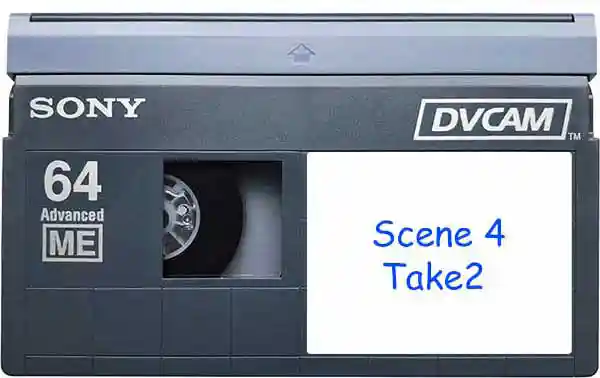
DV-Cam is Sony’s variation of a theme, sitting somewhere between DV and DVC-PRO. DV-Cam still utilises ¼” tape and compression ratio of 5:1 at 25 Mb per second with signal sampling rate of 4:1:1. The tape speed and track width was increased from DV format and metal evaporated tape is used rather than metal particle tape. DV-Cam produces excellent quality pictures and is frequently used within the media industry.
Tapes are available in two sizes:
Standard: cassettes measure 124 x 76 x 14 mm
Mini: cassettes measure 65 x 46 x 11 mm
DVCPRO50
DVCPRO50 was introduced by Panasonic in 1997 for high-value electronic news gathering and digital cinema, and is often described as two DV codecs working in parallel. The DVCPRO50 doubles the coded video data rate to 50 Mbit/s. This has the effect of cutting total record time of any given storage medium in half. Chroma resolution is improved by using 4:2:2 chroma subsampling.
Tapes are available in two sizes:
Standard: cassettes measure 124 x 76 x 14 mm
Mini: cassettes measure 65 x 46 x 11 mm
HDV (High Definition) Tapes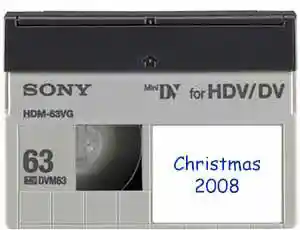
HDV is an inexpensive high-definition video recording format which uses MPEG2 compression to fit HD content onto the same DV or MiniDV tapes originally developed for standard definition recording. The compression used results in some quality compromises compared to higher bandwidth HD recording formats.
The cassettes measure 65 x 46 x 11 mm
Digital8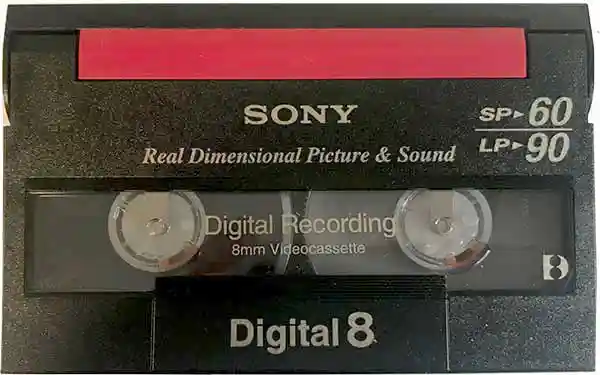
Digital8 (or D8) is a consumer digital recording videocassette for camcorders based on the 8 mm video format developed by Sony, and introduced in 1999.
Sony was once again the first manufacturer to introduce this format, which is far superior to either Hi-8 or 8mm. Basically aimed at the domestic user, the format is backwards compatible. This means that Digital-8 camcorders will also play previously recorded 8mm and Hi-8 tapes. It also employs the same tape format but will only record 60 minutes on a 90 minute Hi-8 cassette, with both digital video and sound. Camcorders are generally the same dimensions as those of 8mm and Hi-8.
The cassettes measure 95 × 62.5 × 15 mm
MicroMV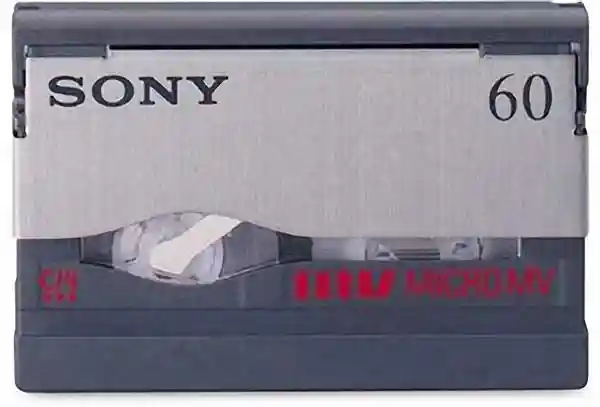
MicroMV was a videotape format introduced in 2001 by Sony. This cassette is physically smaller than a Digital8 or DV cassette. In fact, MicroMV is the smallest videotape format — 70% smaller than MiniDV.
Each cassette can hold up to 60 minutes of video. The MicroMV format does not use the highly popular DV format. Instead, it uses 12 Mbit/s MPEG-2 compression, like that used for DVDs and HDV.
The cassettes measure 45 x 30 x 8 mm
Digital Betacam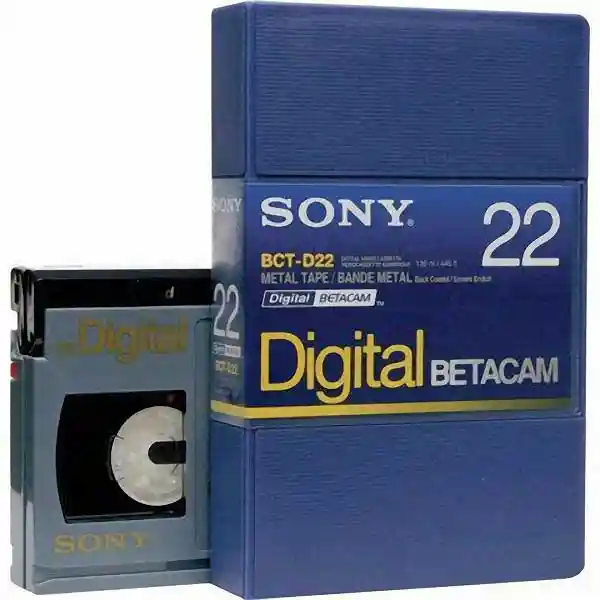
AKA Digibeta or D-Beta, was introduced by Sony in 1993 as a replacement for the analog Betacam SP format. Digital Betacam was superior in performance to DVCam and DVCPro, while being cheaper than D1. Digital Betacam attracted a fair amount of professional support but didn’t go as far as to become an industry standard like it’s predecessor. Cassette sizes are the same as other Beta versions: S (small) tapes record up to 40 minutes, L (large) tapes record up to 124 minutes. Cassettes are light blue. Digital betacam records component video with 10-bit YUV 4:2:2 compression. PAL resolution is 720×576, NTSC resolution is 720×480. The bitrate is 90 Mbit/s. There are 5 audio channels — 4 main channels (uncompressed 48KHz PCM) and 1 cue track.
Tapes are available in two sizes:
Small: cassettes measure 156 x 96 x 25 mm
Large: cassettes measure 254 x 145 x 25 mm
Betacam SX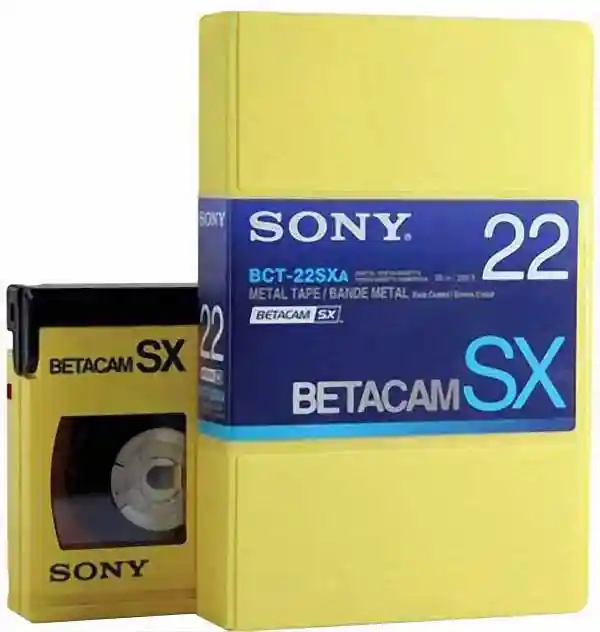
Is a digital version of Betacam SP. Launched in 1996, Betacam SX served as a transitional format which was cheaper than Digital Betacam. It also had the advantage of being compatible with Betacam SP tapes. Betacam SX uses MPEG 4:2:2 compression with 4 channels of 48 KHz 16-bit PCM audio. Betacam SX cassettes come in the same S and L sizes as other Beta formats, coloured yellow. S tapes have a recording time of approximately 60 minutes; L tapes record up to 194 minutes.
Tapes are available in two sizes:
Small: cassettes measure 156 x 96 x 25 mm
Large: cassettes measure 254 x 145 x 25 mm
MPEG IMX
Was designed as the ultimate realisation of this AV/IT vision. It was also critically affected by the needs of major broadcasters in Germany, Italy and Austria who already had a huge installed base of Digital Betacam equipment. Tomorrow’s networked production environment had to match Digital Betacam picture quality as well as integrating the entire Betacam family archive.
Picture quality equivalent to Digital Betacam
50Mbps data rate
MPEG-2 based, non-proprietary codec for maximum interoperability
Tapes are available in two sizes:
Small: cassettes measure 156 x 96 x 25 mm
Large: cassettes measure 254 x 145 x 25 mm
HDCAM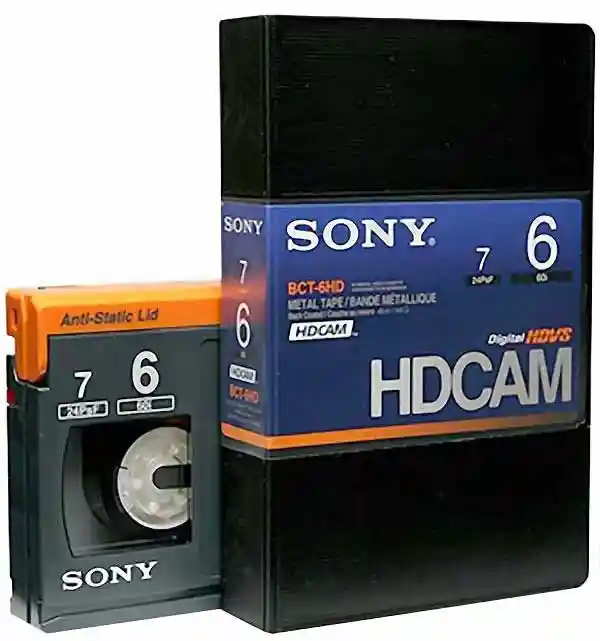
HDCAM, introduced in 1997, is a high-definition video digital recording videocassette version of digital Betacam, using an 8-bit discrete cosine transform (DCT) compressed 3:1:1 recording, in 1080i-compatible down-sampled resolution of 1440×1080, and adding 24p and 23.976 progressive segmented frame (PsF) modes to later models. The HDCAM codec uses rectangular pixels and as such the recorded 1440×1080 content is upsampled to 1920×1080 on playback. The recorded video bit rate is 144 Mbit/s. Audio is also similar, with four channels of AES3 20-bit, 48 kHz digital audio.
Like Betacam, HDCAM tapes are produced in small and large cassette sizes; the small cassette uses the same form factor as the original Betamax.
Tapes are available in two sizes:
Small: cassettes measure 156 x 96 x 25 mm
Large: cassettes measure 254 x 145 x 25 mm
- DV
- Digital 8
- Micro MV
- Beta
MiniDV
Digital Video (DV) is a video format launched in 1996, and, in its smaller tape form factor MiniDV, became one of the standards for consumer and semi-professional video production. The DV specification (originally known as the Blue Book) defines both the codec and the tape format. Features include intraframe compression for uncomplicated editing, and good video quality, especially compared to earlier consumer analog formats such as 8 mm, Hi-8 and VHS-C. DV now enables filmmakers to produce movies inexpensively, associated with no-budget cinema. DV uses DCT intraframe compression at a fixed bitrate of 25 megabits per second.
The tape measure 65 x 46 x 11 mm
DVCAM
DV-Cam is Sony’s variation of a theme, sitting somewhere between DV and DVC-PRO. DV-Cam still utilises ¼” tape and compression ratio of 5:1 at 25 Mb per second with signal sampling rate of 4:1:1. The tape speed and track width was increased from DV format and metal evaporated tape is used rather than metal particle tape. DV-Cam produces excellent quality pictures and is frequently used within the media industry.
Tapes are available in two sizes:
Standard: tape measure 124 x 76 x 14 mm
Mini: tape measure 65 x 46 x 11 mm
DVCPRO50
DVCPRO50 was introduced by Panasonic in 1997 for high-value electronic news gathering and digital cinema, and is often described as two DV codecs working in parallel. The DVCPRO50 doubles the coded video data rate to 50 Mbit/s. This has the effect of cutting total record time of any given storage medium in half. Chroma resolution is improved by using 4:2:2 chroma subsampling.
Tapes are available in two sizes:
Standard: tape measure 124 x 76 x 14 mm
Mini: tape measure 65 x 46 x 11 mm
HDV
HDV is an inexpensive high-definition video recording format which uses MPEG2 compression to fit HD content onto the same DV or MiniDV tapes originally developed for standard definition recording. The compression used results in some quality compromises compared to higher bandwidth HD recording formats.
The tape measure 65 x 46 x 11 mm
Digital8
Digital8 (or D8) is a consumer digital recording videocassette for camcorders based on the 8 mm video format developed by Sony, and introduced in 1999.
Sony was once again the first manufacturer to introduce this format, which is far superior to either Hi-8 or 8mm. Basically aimed at the domestic user, the format is backwards compatible. This means that Digital-8 camcorders will also play previously recorded 8mm and Hi-8 tapes. It also employs the same tape format but will only record 60 minutes on a 90 minute Hi-8 cassette, with both digital video and sound. Camcorders are generally the same dimensions as those of 8mm and Hi-8.
The tape measure 95 × 62.5 × 15 mm
MicroMV
MicroMV was a videotape format introduced in 2001 by Sony. This cassette is physically smaller than a Digital8 or DV cassette. In fact, MicroMV is the smallest videotape format — 70% smaller than MiniDV.
Each cassette can hold up to 60 minutes of video. The MicroMV format does not use the highly popular DV format. Instead, it uses 12 Mbit/s MPEG-2 compression, like that used for DVDs and HDV.
Digital Betacam
AKA Digibeta or D-Beta, was introduced by Sony in 1993 as a replacement for the analog Betacam SP format. Digital Betacam was superior in performance to DVCam and DVCPro, while being cheaper than D1. Digital Betacam attracted a fair amount of professional support but didn’t go as far as to become an industry standard like it’s predecessor. Cassette sizes are the same as other Beta versions: S (small) tapes record up to 40 minutes, L (large) tapes record up to 124 minutes. Cassettes are light blue. Digital betacam records component video with 10-bit YUV 4:2:2 compression. PAL resolution is 720×576, NTSC resolution is 720×480. The bitrate is 90 Mbit/s. There are 5 audio channels — 4 main channels (uncompressed 48KHz PCM) and 1 cue track.
Tapes are available in two sizes:
Small: tape measure 156 x 96 x 25 mm
Large: tape measure 254 x 145 x 25 mm
Betacam SX
Is a digital version of Betacam SP. Launched in 1996, Betacam SX served as a transitional format which was cheaper than Digital Betacam. It also had the advantage of being compatible with Betacam SP tapes. Betacam SX uses MPEG 4:2:2 compression with 4 channels of 48 KHz 16-bit PCM audio. Betacam SX cassettes come in the same S and L sizes as other Beta formats, coloured yellow. S tapes have a recording time of approximately 60 minutes; L tapes record up to 194 minutes.
Tapes are available in two sizes:
Small: tape measure 156 x 96 x 25 mm
Large: tape measure 254 x 145 x 25 mm
MPEG IMX
Was designed as the ultimate realisation of this AV/IT vision. It was also critically affected by the needs of major broadcasters in Germany, Italy and Austria who already had a huge installed base of Digital Betacam equipment. Tomorrow’s networked production environment had to match Digital Betacam picture quality as well as integrating the entire Betacam family archive.
Picture quality equivalent to Digital Betacam
50Mbps data rate
MPEG-2 based, non-proprietary codec for maximum interoperability.
Tapes are available in two sizes:
Small: tape measure 156 x 96 x 25 mm
Large: tape measure 254 x 145 x 25 mm
HDCAM
HDCAM, introduced in 1997, is a high-definition video digital recording videocassette version of digital Betacam, using an 8-bit discrete cosine transform (DCT) compressed 3:1:1 recording, in 1080i-compatible down-sampled resolution of 1440×1080, and adding 24p and 23.976 progressive segmented frame (PsF) modes to later models. The HDCAM codec uses rectangular pixels and as such the recorded 1440×1080 content is upsampled to 1920×1080 on playback. The recorded video bit rate is 144 Mbit/s. Audio is also similar, with four channels of AES3 20-bit, 48 kHz digital audio. Like Betacam, HDCAM tapes are produced in small and large cassette sizes; the small cassette uses the same form factor as the original Betamax.
Tapes are available in two sizes:
Small: tape measure 156 x 96 x 25 mm
Large: tepe measure 254 x 145 x 25 mm

